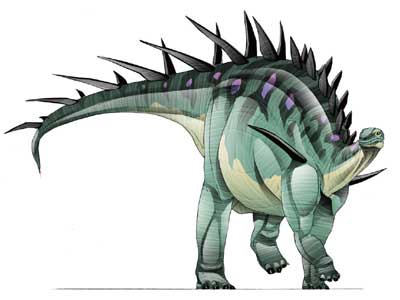Kentrosaurus hennig - Heribivore Dinosaurs
Homepage > Herbivore Dinosaurs - Kentrosaurus hennig
(ken-troh-sor-uhss)
"sharp point lizard"
Describer Hennig, 1915
Also Known As Doryphorosaurus Nopcsa, 1916
Type of Species hennig
Order Ornithischia
SubOrder Thyreophora
InfraOrder Stegosauria
Micro-Order --
Family Stegosauridae
Size 17 feet (5.2 meters) long
Period Late Jurassic,155 million years ago
Fossilsite Tanzania
Diet Herbivore
Kentrosaurus lived during the Late Jurassic Period, about 155 million years ago in what is now Tanzania, Africa. Kentrosaurus name was inspired by the dinosaurs' large spikes along its back and tail. These spikes were not attached to its bones, so none can be entirely certain to where these spikes were located on its body. There is speculation that these spikes were used as body armor for self defense, or they may have been used to attract other mates. It had as many as seven pairs of spikes extending from the end of the tail, up over the hips, and onto the lower back. In front of the spikes there were seven pairs of plates extending all the way up to its neck. These plates were smaller and much narrower than those found on Stegosaurus.

Its trail was flexible and was not made stiff by bony tendons. The tail contain sharp, pointy spikes, may have been used to ward off predators, by swinging its tail from side to side, and Kentrosaurus standing perpendicular to its enemy. Kentrosaurus soft belly was vulnerable to an attack, it was not protected. One of the two skeletons of Kentrosaurus that were pieced together from hundreds of bones, was taken to Germany, and put on display in the Humboldt Museum, Berlin. The skeleton was destroyed during a bombing of the city, during World War II. It has been replaced since, with a copy of the second skeleton, which is still in display in Tubingen.